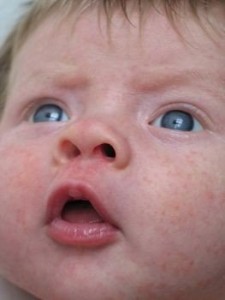Milk is the number one food source for infants below one year old. And over 100,000 babies are diagnosed each year to have suffered from milk allergy in infants. Milk allergy in infants usually develops within the first year and the child usually outgrows it as he ages.

It’s normal for newborn babies to become fussy most of the time. Most first time moms probably think that their babies have milk allergy or milk intolerance when they manifest fussiness while or after feeding. Milk intolerance occurs when the body lacks the certain enzymes that help digest milk, particularly lactose inside the intestines. While with milk allergy, the baby’s immune system treats the milk as a harmful substance so it releases anti bodies to fight it. These anti bodies cause the onset of milk allergy symptoms.
Symptoms of Milk Allergy in Infants
Allergic responses are not the same with every infant. Also, some symptoms can be immediate while others are delayed. The immune system has several ways of reacting to milk allergies, which include:
• Classic Ig-E mediated food allergy
Symptoms appear within 30 minutes or less after feeding your baby with milk formula. Cow’s milk is basically the most common cause of milk allergies. Signs of milk allergy are the following:
• When your baby unstoppably cries for hours for at least 3 weeks, then most probably he is suffering from acid reflux due to milk allergy. This infant behavior is known as colic and you can easily identify this due to the baby’s inconsolable nature.
• Your baby starts to show skin reactions such as hives, eczema, and a severe type of diaper rash.
• Throat, tongue, and lip swelling can be seen on infants with milk allergy. Oftentimes, these lead to breathing difficulties which can be very dangerous for infants
• Abdominal pain can be present. You can observe that your baby cries unstoppably and tries to pull his knees up to his chest.
• Vomiting can also be present.
• Diarrhea is a very common milk allergy symptom in infants. If blood is present in the baby’s stool then it indicates a more serious type of milk allergy.
• Eosinophilic Gastrointestinal Disorder (EGID)
Eosinophils are white blood cells that occupy the digestive tract at low numbers, but when exposed to allergic attacks, they multiply and attack the body which causes the following symptoms depending on the eosinophils’ location:
• Feeding difficulty
• Pain during swallowing
• Failure to thrive
• Abdominal pain
• Weight loss
• Diarrhea
• Food Protein-Induced Enterocolitis Syndrome (FPIES)
This type of immune response is the most severe type that usually occurs on the first months of an infant’s life. Symptoms include:
• Diarrhea
• Vomiting
• Bloody stools
• Shock (although this is rare)
Treatment of Milk Allergy in Infants
Milk allergy in infants are mostly caused by cow’s milk, thus, the best way is to avoid feeding your child with cow’s milk or soy milk, and look for other milk alternatives. Hypo-allergenic milk is quite expensive so it is best to breastfed your baby as much as possible. But as mentioned, infants may outgrow this milk allergy so moms can slowly introduce cow’s milk probably after the baby’s first birthday.